Jay Gould
| Jay Gould | |
|---|---|
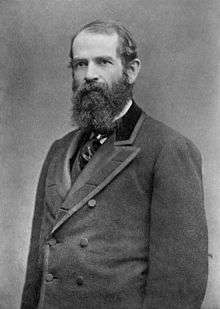 | |
| Born |
Jason Gould May 27, 1836 Roxbury, New York, U.S.[1] |
| Died |
December 2, 1892 (aged 56) New York, New York, U.S. |
| Occupation | Financier |
| Religion | Presbyterian |
| Spouse(s) | Helen Day Miller (1838–1889) (m. 1863–89) |
| Children | |
| Parent(s) |
John Burr Gould (1792–1866) Mary More (1798–1841) |
Jason "Jay" Gould (May 27, 1836 – December 2, 1892) was a leading American railroad developer and speculator. He has been referred to as one of the ruthless robber barons of the Gilded Age, whose success at business made him one of the richest men of his era. He was hated and reviled, but some modern historians like Walter R. Borneman and Maury Klein, working from primary sources, have attempted to discount his negative portrayal.[2][3][4]
Early life and education
Jason Gould was born in Roxbury, New York to Mary More (1798–1841) and John Burr Gould (1792–1866). His maternal grandfather, Alexander T. More, was a businessman, and his great-grandfather John More was a Scottish immigrant who founded the town of Moresville, New York.[5] Jay Gould studied at local schools and the Hobart Academy in Hobart, Delaware County, New York.[6]
As a young boy, Gould decided he wanted nothing to do with farming which was what his father did, and so his father dropped him off at a nearby school with 50 cents and a sack of clothes.[7]
Early career

His principal was credited as getting him a job working as a bookkeeper for a blacksmith.[8] A year later the blacksmith offered him half interest in the blacksmith shop, which he sold to his father during the early part of 1854. Gould devoted himself to private study, emphasizing surveying and mathematics. In 1854, Gould surveyed and created maps of the Ulster County, New York area. In 1856 he published History of Delaware County, and Border Wars of New York, which he had spent several years writing.[9]
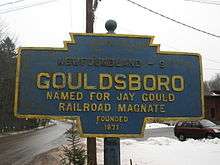
In 1856, Gould entered a partnership with Zadock Pratt [8] to create a tanning business in Pennsylvania in what would become Gouldsboro. Eventually, he bought out Pratt, who retired. In 1856, Gould entered another partnership with Charles Mortimer Leupp, a son-in-law of Gideon Lee, and one of the leading leather merchants in the United States at the time. Leupp and Gould was a successful partnership until the Panic of 1857. Leupp lost all his money, while Gould took advantage of the opportunity of the depreciation of property value and bought up former partnership properties for himself.[8]
After the death of Charles Leupp, the Gouldsboro Tannery became a disputed property. Leupp's brother-in-law, David W. Lee, who was also a partner in Leupp and Gould, took armed control of the tannery. He believed that Gould had cheated the Leupp and Lee families in the collapse of the business. Eventually, Gould took physical possession, but was later forced to sell his shares in the company to Lee's brother.[10]
Railroad investing
In 1859 Gould began speculative investing by buying stock in small railways. Gould's father-in-law Daniel S. Miller was credited with introducing the younger man to the railroad industry, when he suggested that Gould help him save his investment in the Rutland and Washington Railroad in the Panic of 1857. Gould purchased stock for 10 cents on the dollar, which left him in control of the company.[11] Through the Civil War era, he did more speculation on railroad stocks in New York City. In 1863 he was appointed manager of the Rensselaer and Saratoga Railroad.
The Erie Railroad encountered financial troubles in the 1850s, despite receiving loans from financiers Cornelius Vanderbilt and Daniel Drew. The Erie entered receivership in 1859 and was reorganized as the Erie Railway. Jay Gould, Drew and James Fisk engaged in stock manipulations known as the Erie War, with the result that in the summer of 1868 Drew, Fisk, and Vanderbilt lost control of the Erie, while Gould became its president.[12]
Tweed Ring
It was during the same period that Gould and Fisk became involved with Tammany Hall, the New York City political ring. They made Boss Tweed a director of the Erie Railroad, and Tweed, in return, arranged favorable legislation for them. Tweed and Gould became the subjects of political cartoons by Thomas Nast in 1869. In October 1871, when Tweed was held on $1 million bail, Gould was the chief bondsman.[13]
Black Friday
In August 1869, Gould and Fisk began to buy gold in an attempt to corner the market, hoping that the increase in the price of gold would increase the price of wheat such that western farmers would sell, causing a great amount of shipping of bread stuffs eastward, increasing freight business for the Erie railroad. During this time, Gould used contacts with President Ulysses S. Grant's brother-in-law, Abel Corbin, to try to influence the president and his Secretary General Horace Porter.
These speculations in gold culminated in the panic of Black Friday, on September 24, 1869, when the premium over face value on a gold Double Eagle fell from 62 percent to 35 percent. Gould made a small profit from this operation, but lost it to subsequent lawsuits. The gold corner established Gould's reputation in the press as an all-powerful figure who could drive the market up and down at will.
Lord Gordon-Gordon

In 1873 Gould attempted to take control of the Erie Railroad by recruiting foreign investments from Lord Gordon-Gordon, whom he believed was a cousin of the wealthy Campbells looking to buy land for immigrants. He bribed Gordon-Gordon with $1 million in stock. But Gordon-Gordon was an impostor and cashed the stock immediately. Gould sued Gordon-Gordon; the case went to trial in March 1873. In court, Gordon-Gordon gave the names of the Europeans whom he claimed to represent, and was granted bail while the references were checked. He fled to Canada, where he convinced authorities that the charges against him were false.[14][15]
After failing to convince or force Canadian authorities to hand over Gordon-Gordon, Gould and his associates, which included two future governors of Minnesota and three future members of Congress (Loren Fletcher, John Gilfillan, and Eugene McLanahan Wilson) attempted to kidnap him. The group snatched him successfully, but they were stopped and arrested by the North-West Mounted Police before they could return to the United States. The kidnappers were put in prison and refused bail.[14][15] This led to an international incident between the United States and Canada. Upon learning that the kidnappers were not given bail, Governor Horace Austin of Minnesota demanded their return; he put the local militia on a state of full readiness. Thousands of Minnesotans volunteered for a full military invasion of Canada. After negotiations, the Canadian authorities released the kidnappers on bail.[14][15] The incident resulted in Gould losing any possibility of taking control of Erie Railroad.
Western railroads
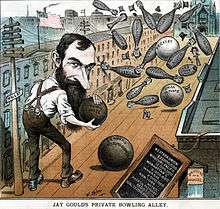
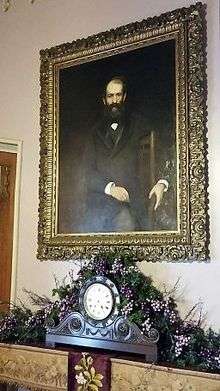
After being forced out of the Erie Railroad, Gould started to build up a system of railroads in the Midwest and West. He took control of the Union Pacific in 1873 when its stock was depressed by the Panic of 1873 and built a viable railroad that depended on shipments by local farmers and ranchers. Gould immersed himself in every operational and financial detail of the UP system. He built an encyclopedic knowledge, then acted decisively to shape its destiny. "He revised its financial structure, waged its competitive struggles, captained its political battles, revamped its administration, formulated its rate policies, and promoted the development of resources along its lines."[16][17] After Gould's death, the Union Pacific slipped and declared bankruptcy during the Panic of 1893.
By 1879, Gould gained control of three more important western railroads, including the Missouri Pacific Railroad.He controlled 10,000 miles (16,000 km) of railway, about one-ninth of the length of rail in the United States at that time, and, by 1882, he had controlling interest in 15 percent of the country's trackage. Because the railroads were making profits and had control of rate setting, his wealth increased dramatically. When Gould withdrew from management of the Union Pacific in 1883 amidst political controversy over its debts to the federal government, he realized a large profit for himself. He obtained a controlling interest in the Western Union telegraph company, and, after 1881, in the elevated railways in New York City. In 1889, Gould organized the Terminal Railroad Association of St. Louis, which acquired a bottleneck in east-west railroad traffic at St. Louis; after Gould's death the government brought an antitrust suit to eliminate the bottleneck control.[18]
Personal life
Timeline
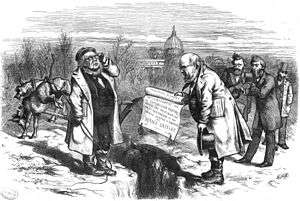
- 1836 Birth of Jay Gould as Jason Gould
- 1841 Death of Mary Moore Gould, mother
- 1850 Jay Gould in US census in Roxbury, New York
- 1856 Publication of History of Delaware County
- 1863 Marriage to Helen Day Miller (1838–1889)
- 1864 Birth of George Jay Gould I, his son
- 1866 Death of John Burr Gould, his father
- 1866 Birth of Edwin Gould, his son
- 1868 Birth of Helen Gould, his daughter
- 1869 Black Friday
- 1870 Jay Gould in US census in first Manhattan home
- 1870 Jay Gould in US census in second Manhattan home
- 1871 Birth of Howard Gould, his son
- 1875 Birth of Anna Gould, his daughter
- 1877 Birth of Frank Gould, his son
- 1880 Purchase of Lyndehurst from the widow of George Merritt, shortening name to Lyndhurst
- 1880 Jay Gould in US census in Greenburgh, New York
- 1889 Death of Helen Day Miller, his wife
- 1892 Obituary of Jay Gould
Religion
Gould was a member of West Presbyterian Church at 31 West 42nd Street. It later merged with Park Presbyterian to form West-Park Presbyterian.[19]
Marriage
He married Helen Day Miller (1838–1889) in 1863; the couple had six children:
- George Jay Gould I (1864–1923), married Edith M. Kingdon (1864–1921)[20]
- Edwin Gould I (1866–1933), married Sarah Cantine Shrady[21]
- Helen Gould (1868–1938), married Finlay Johnson Shepard (1867–1942)[22]
- Howard Gould (1871–1959), married Viola Katherine Clemmons on October 12, 1898; and later married actress Grete Mosheim in 1937[23]
- Anna Gould (1875–1961), married Paul Ernest Boniface, Comte de Castellane (1867–1932) and divorced; second, married Hélie de Talleyrand-Périgord, 5th duc de Talleyrand, 5th duc de Dino, 4th Herzog von Sagan, and Prince de Sagan (1858–1937)[24]
- Frank Jay Gould (1877–1956), married Helen Margaret Kelly; then Edith Kelly (not related to his first wife); and then Florence La Caze (1895–1983)[25]
Death
_pg522_JAY_GOULD'S_MAUSOLEUM%2C_AT_WOOOLAWN_CEMETERY.jpg)
Gould died of tuberculosis on December 2, 1892, and was interred in the Woodlawn Cemetery, The Bronx, New York. His fortune was conservatively estimated at $72 million for tax purposes, which he willed in its entirety to his family.[6]
At the time of his death, Gould was a benefactor in the reconstruction of the Reformed Church of Roxbury, New York, now known as the Jay Gould Memorial Reformed Church.[26] It is located within the Main Street Historic District and listed on the National Register of Historic Places in 1988.[27] The family mausoleum was designed by Francis O'Hara.
Legacy
Jason Gould married Helen Day Miller (1838–1889) in 1863 and had six children:
- George Jay Gould I (1864–1923), married Edith M. Kingdon (1864–1921)[20]
- Kingdon Gould, Sr. (1887–1945) who married Annunziata Camilla Maria Lucci (1890–1961).[28]
- Jay Gould II (1888–1935) who was a tennis player and who married Anne Douglass Graham.[29]
- Marjorie Gould (1891–1955) who married Anthony Joseph Drexel II
- Helen, Lady Decies (1893–1931) who married John Graham Hope DeLaPoer Horsley Beresford (1866–1945)[30]
- George Jay Gould II (1896–?) who married Laura Carter[31]
- Edith, Lady MacNeal (1901–1937) who married Carroll Livingston Wainwright I (1899–1967) and after a divorce married Sir Hector Murray MacNeal[32]
- Gloria Gould (1906–1943) who married Henry A. Bishop II, and after a divorce married Walter McFarlane Barker.[33]
- Edwin Gould I (1866–1933), married Sarah Cantine Shrady[21][34][35] She inherited $US 10,000,000 upon his death. They had two sons:
- Edwin Gould, Jr., (1894–1917). He died on Jekyl Island in 1917.[36][37]
- Frank Miller Gould (c. 1895–1945). He graduated from Yale in 1920, married Florence Amelia Bacon on November 17, 1924, she was from Dallas, Texas. Frank died on January 13, 1945.[21][38] They had two children:
- Marianne Gould (1926 – January 21, 1957)
- Edwin Jay Gould (1932–1993).
- Helen Gould (1868–1938), married Finlay Johnson Shepard (1867–1942)[22] They adopted three children, Finley Jay, named for Finley Johnson Shepard and Jay Gould, and Olivia, named for Helen's dear friend Mrs. Russell Sage, and Helen Anna, named for Helen and her sister, Anna and had one foster child, Louis Seton. The first of the adopted children, Finley Jay Shepard, was a three-year-old child found abandoned on the steps of St. Patrick's Cathedral, New York in 1914. They later adopted two daughters, Margaret and Dorothy, of her brother Frank Gould.[39]
- Howard Gould (1871–1959), married Viola Katherine Clemmons on October 12, 1898; and later married actress Grete Mosheim in 1937[23]
- Anna, Duchess de Talleyrand-Périgord (1875–1961), married Paul Ernest Boniface, Comte de Castellane (1867–1932); and, after a divorce, married Hélie de Talleyrand-Périgord, 5th duke of Talleyrand, 5th duc of Dino, 4th Duke von Sagan, and Prince of Sagan (1858–1937)[24] With Boniface, Anna had the following five children:
- Marie Louise Boniface de Castellane (1896 – ?), died during infancy or early childhood
- Antoine Boniface, Marquis de Castellane (1896–1946), married Yvonne Patenôtre (daughter of Jules Patenôtre and wife Eleanor Elverson, sister of James Elverson, Jr. (?–1929) and daughter of publisher James Elverson (1838–1911) by wife Sallie Duvall, the three of them owners of The Philadelphia Inquirer). He had daughter Elisabeth de Castellane (Paris, July 9, 1928 – Paris, November 13, 1991), wife (married in Paris, December 7, 1948) of Jean Bertrand Jacques Adrien Nompar Comte de Caumont La Force (Paris, February 4, 1920 – Fontaine Française, June 8, 1986).[40]
- Georges Paul Ernest Boniface de Castellane (1897 or 1899–1944), married Florinda Fernández y Anchorena (1901–?). They had daughter:
- Diane Rose Anne Marie de Castellane (born in Paris, February 19, 1927). She married Philippe François Armand Marie Duc de Mouchy Prince-Duc de Poix (born in Paris, April 17, 1922) in Paris in a civil ceremony on April 14, 1948; and a church ceremony on April 20, 1948; they divorced on March 13, 1974.
- Georges Gustave Boniface de Castellane (circa 1898–1946)
- Jay Boniface de Castellane (1902–?)
- With Talleyrand, Anna had the following two children:
- Howard de Talleyrand, duc de Sagan (1909–1929), he took his own life when told he could not marry.[41][42]
- Helen Violette de Talleyrand-Périgord (1915–2003), she married James Robert de Pourtales on March 29, 1937, in Val Saint-Germain, she then divorced in 1969, and married Gaston Palewski (1901–1984), he was the Minister of Scientific Research and Atomic and Space Questions from 1962 to 1966. They married on March 20, 1969, in Paris.
- Frank Jay Gould (1877–1956), married Helen Kelley; then Edith Kelly; and then Florence La Caze (1895–1983)[25]
In popular culture
- Jay Gould is a key character in the 2014 historical murder mystery novel The New Colossus by Marshall Goldberg, published by Diversion Books,[43] in which reporter Nellie Bly is assigned by publisher Joseph Pulitzer to investigate the 1887 death of poet Emma Lazarus.
- He is a character in the final episode of The Adams Chronicles mini-series. The program discusses his activities with respect to the Union Pacific Railroad and Charles Francis Adams II.
- Jason Gould was portrayed in the 2012 History Channel documentary 'The Men Who Built America'
See also
- Lyndhurst, his country estate on the Hudson River
- Paragould, Arkansas
Notes
- ↑ Maury Klein (October 29, 1997). The Life and Legend of Jay Gould. Johns Hopkins University Press. p. 15. ISBN 978-0-8018-5771-3.
- ↑ Walter R. Borneman (2014). Iron Horses: America's Race to Bring the Railroads West. p. 235. ISBN 9780316371797.
- ↑ Maury Klein (1997). The Life and Legend of Jay Gould. p. 393. ISBN 9780801857713.
- ↑ Rennehan, Edward J. (2005). Dark Genius of Wall Street.
- ↑ "John More - biography". Find A Grave. Retrieved 5 March 2016.
- 1 2 Alef, Daniel (2010). Jay Gould: Ruthless Railroad Tycoon. Titans of Fortune Publishing. ISBN 9781608043064.
- ↑ H. W. Brands "Masters of Enterprise"
- 1 2 3 GOULD'S EVENTFUL LIFE, http://query.nytimes.com/mem/archive-free/pdf?res=9907EFDE1638E233A25750C0A9649D94639ED7CF
- ↑ Gould, Jay (1856). History of Delaware County. Philadelphia, Pennsylvania?: Keeny & Gould.
- ↑ "David Williamson Lee's Career", New York Times, January 21, 1886.
- ↑ Klein, Maury (1997). The Life and Legend of Jay Gould. Johns Hopkins University Press. p. 508. ISBN 9780801857713.
- ↑ Schafer, Mike (2000). More Classic American Railroads. MBI Publishing Company. p. 47. ISBN 076030758X. Retrieved September 22, 2016.
- ↑ Conway, J. North (2010). The Big Policeman: The Rise and Fall of America's First, Most Ruthless, and Greatest Detective. Globe Pequot Press. p. 99. ISBN 9781599219653.
- 1 2 3 Donaldson, William (2004-09-02). Brewer's Rogues, Villains and Eccentrics. London: Phoenix. pp. 299–300. ISBN 0-7538-1791-8.
- 1 2 3 Johnson, J.L. "Lord Gordon Gordon". The Manitoba Historical Society. Retrieved 2008-08-22.
- ↑ Maury Klein, Jay Gould, (1966) p 147
- ↑ Maury Klein, "In Search of Jay Gould." Business History Review 52#2 (1978): 166-199.
- ↑ United States v. Terminal R.R. Ass'n.
- ↑ New York City Landmarks Preservation Commission. New York City Landmarks Preservation Commission: "Designation List 425", nyc.gov; accessed May 3, 2014.
- 1 2 "George J. Gould Dies in Villa in France. Leaves $30,000,000. With His Second Wife and Her Children Near, He Yearned for His Sons. Last Malady a Secret. Death Holds Up Litigation With Family Over His Father's Estate. First Became Ill in March. Had Apparently Regained Health When He Suffered a Relapse.". New York Times. May 17, 1923. Retrieved 2008-05-23.
George Jay Gould died this morning at 3:30 o'clock at the Villa Zoralde, Cap Martin, where he had been living for some months with his wife and her two children. His death, it was stated at the villa, came quietly and was expected, as he had never rallied from the illness from which he had been suffering all Winter.
- 1 2 3 "Edwin Gould Dies Suddenly at 67. Son of Railroad Financier and Builder Was Noted for Benefactions to Children. Left School of Finance. Made $1,000,000 Profit Operating Alone in Wall Street Before Father Forgave Him.". New York Times. July 13, 1933. Retrieved 2008-08-06.
Edwin Gould, second son of the late Jay Gould, financier and railroad builder, died suddenly of a heart attack shortly after ...
- 1 2 "Mrs. F.J. Shepard Dies of a Stroke. Former Helen Gould, Famous for Philanthropy, Stricken at Her Summer Home Gave Away Much of Fortune. Mrs. Finley J. Shepard Is Stricken at 70. Philanthropist and Daughter of Jay Gould Got Permission to Marry. Wed at Lyndhurst. Benefactions in War With Spain. Descendant of Pioneers.". New York Times. December 21, 1938. Retrieved 2007-06-18.
Mrs. Finley J. Shepard of New York, the former Helen Gould, who was famous for her philanthropies in many fields, died at her Summer home here at 12:15 this morning, after being in a coma for more than 24 hours. She had suffered an apoplectic stroke ten days ago, and had been ill for two months. Her age was 70 years.
- 1 2 "Howard Gould dies here at 88... [l]ast surviving son of Jay Gould, rail financier, yachtsman, auto racer.". New York Times. September 15, 1959. Retrieved 2007-06-21.
Howard Gould, last surviving son of Jay Gould, the railroad financier, died Sunday in Doctors Hospital. He was 88 years old. Although Mr. Gould's residence ...
- 1 2 "Duchesse de Talleyrand Is Dead. Youngest daughter of Jay Gould". New York Times. November 30, 1961. Retrieved 2008-08-06.
The Duchesse de Talleyrand-Périgord, daughter of the late Jay Gould, American railroad financier, died today in Paris where she passed most of her life.
- 1 2 "Frank Jay Gould Dead on Riviera. Youngest Son of Rail Empire Maker was 78. Built Up Resort of Juan-les-Pins Heir to $10,000,000 N.Y.U. Graduate of 1899.". Associated Press in New York Times. April 1, 1956. Retrieved 2008-04-06.
Frank Jay Gould died today at his apartment at Juanles-Pins on the French Riviera. He was 78 years old
- ↑ History of the Reformed Church of Roxbury, Delaware County, New York, churches.rca.org; accessed May 3, 2014.
- ↑ National Park Service (2009-03-13). "National Register Information System". National Register of Historic Places. National Park Service.
- ↑ "Kingdon Gould, 58, Long a Financier. Grandson of Founder of Family Fortune Dies. Once on Rail Boards. Officer In 1918.". New York Times. November 8, 1945. Retrieved 2008-06-19.
Kingdon Gould, financier eldest son of the late George J. and Edith Kingdon Gould, and grandson of Jay Gould, financier and railroad ...
- ↑ "Jay Gould Is Dead. Court Tennis Star. Grandson of the Financier Had Held Championship for Quarter of Century.". New York Times. January 28, 1935. Retrieved 2007-07-21.
Sportsman Succumbs in Up-State Hospital at 46. His Body Brought Here for Funeral.
- ↑ "Lady Decies Dies at 38 in London. Former Helen Vivien Gould Was Principal in Brilliant International Wedding of 1911. Was Noted As Hostess. Her Entertaining Was a Feature of British Capital. Husband Is Distinguished Irish Peer.". New York Times. February 3, 1931. Retrieved 2007-11-26.
Lady Decies, the former Helen Vivien Gould, daughter of the late George Jay Gould of New York, died in London this morning. She had been critically ill here for several days.
- ↑ "He Is George Jay Gould, Jr.". New York Times. May 15, 1896. Retrieved 2008-08-22.
The third son and fifth child of Mr. and Mrs. George J. Gould was christened at noon to-day in All Saints' Memorial Church ...
- ↑ "Lady MacNeal Dies. Was Edith Gould. Granddaughter of Financier, 36, Succumbs at Estate in East Hampton. Wife of British Knight. Wrote Autobiography Telling of Family Life ...". New York Times. September 12, 1937. Retrieved 2008-08-22.
Lady MacNeal, the former Edith Gould, granddaughter of the late Jay Gould, died at Gulf Crest, her estate here, late last night. Lady MacNeal, who was 36 years old, had been in poor health for two years. Death was caused by a liver ailment. Born on Father's Yacht. Edith Catherine Gould, next to the youngest of seven children, was the daughter of the late George J. Gould and Edith Kingdon Gould. ...
- ↑ "Gloria Gould Barker Is Drowned In Swim Pool at Arizona Home. Mrs. W.M. Barker Drowns In A Pool. Victim of Accident.". Associated Press in New York Times. August 16, 1943. Retrieved 2008-06-07.
Mrs. Gloria Gould Barker, 37, a member of the prominent Gould family of New York, was drowned today in the swimming pool of her desert home ten miles east of here.
- ↑ Gould; Time (magazine); July 31, 1933
- ↑ New York Times; October 15, 1951, Monday; Mrs. Edwin Gould Dies in Hospital; Widow of Financier's Son Was Daughter of Surgeon Who Attended President Grant.
- ↑ Sublimed Gould; Time (magazine); July 24, 1933
- ↑ New York Times; February 26, 1917, Monday; Edwin Gould, Jr., Killed on Hunt with Own Gun; Was Clubbing 'Coon Caught in Trap When Trigger Caught, Firing the Weapon. Shot Severed Artery. Young Hunter Died Before His Sole Companion on Lonely Island Could Give Aid. Father is Bringing Body. Mother Prostrated at News of Tragedy, Which Occurred Near Jekyl Island. Left the Body and Called Help. Followed a Local Custom. Mother Prostrated by the News. Edwin Gould, Jr., Killed on Hunt. Had Chosen a Business Career. Brunswick, Georgia, February 25, 1917. Edwin Gould, Jr., 23 years old, who was staying at his father's Winter home on Jekyl Island, was killed last night by the discharge of a shotgun in his hands while he was trying to kill a raccoon found in a trap he had set.
- ↑ New York Times; January 14, 1945; Frank M. Gould, 45 Dies at Oyster Bay; Son of Edwin and Grandson of Jay Was Rail Executive. Owned Prize Horses. Oyster Bay, Long Island; January 13, 1945. Frank Miller Gould, only surviving son of the late Edwin Gould and a grandson of Jay Gould, financier and railroad builder, died at his home here today after a long illness. He would have been 46 years old on February 6.
- ↑ Snow, Alice Northrop (1943). The Story of Helen Gould. F. H. Revell.
- ↑ "Son of Ann Gould succumbs in Paris.". New York Times. February 8, 1946.
Marquis De Castellane Held French Embassy Posts in London During 1940. Paris, Feb. 7, 1946. The death of Marquis de Castellane, son of the late Count Boni de Castellane and the former Anna Gould of New York, who eventually became Duchess de Talleyrand-Périgord, was announced today.
- ↑ "Talleyrand Motel". Time magazine. June 3, 1929. Retrieved 2007-07-21.
Prince of Sagan, son of the Duchess de Talleyrand, who was Anna, the daughter of the late wealthy Jay Gould, shot himself on purpose in his mother's Paris home. ... 'The Duke and Duchess de Talleyrand regret keenly to announce the critical illness of their son, Howard. ... He shot himself because we refused him permission to marry until he was 21. ... The shooting took place in our home and our son was taken to a hospital in the Rue Puccini. ... Our son is now in an extremely grave condition. We wish to emphasize that we had no objection to the girl, but only opposed the marriage because of our son's age.'
- ↑ "Anna Gould's Son, Self-Wounded, Dies. Howard De Talleyrand, Prince De Sagan, 19, Succumbs In Paris After 11 Days. Parent's At His Bedside". New York Times. May 29, 1929. Retrieved 2007-07-21.
Howard de Talleyrand, Prince de Sagan, 19-year-old son of the Duc de Talleyrand and the former Anna Gould, died early this morning following a self-inflicted wound on May 17 after his parents had refused him immediate permission to marry.
- ↑ "The New Colossus". diversionbooks.com/ebooks/new-colossus. Retrieved 2014-04-29.
Further reading
- Death of Jay Gould in the Brooklyn Eagle
- Klein, Maury (1997). The Life and Legend of Jay Gould. The Johns Hopkins University Press. ISBN 978-0801857713.
- Grodinsky, Julius (1981). Jay Gould, His Business Career, 1867–1892. Arno Press. p. 627. ISBN 978-1258168681.
- Josephson, Matthew (1962). The Robber Barons: The Great American Capitalists, 1861–1901. New York: Harcourt, Brace & World.
- Hilferding, Rudolf (1981). Finance Capital: A Study of the Latest Phase of Capitalist Development. New York: Routledge and Kegan Paul. ISBN 978-0415436649.
- Renehan, Edward J. (2005). The Dark Genius of Wall Street: The Misunderstood Life of Jay Gould, King of the Robber Barons. New York: BasicBooks. ISBN 0-465-06885-5.
- Morris, Charles R. (2005). The Tycoons: How Andrew Carnegie, John D. Rockefeller, Jay Gould, and J.P. Morgan Invented the American Supereconomy. New York: Holt. ISBN 0-8050-7599-2.
- Kotz, David M. (2008). Neoliberalism and Financialization (PDF). Amherst: University of Massachusetts.
- "George Gould marries". New York Times. 1886-09-15.
- "Howard Gould marries". New York Times. 1898-10-13.
- "Howard Gould dies here at 88; last surviving son of Jay Gould, rail financier — yachtsman, auto racer". New York Times. 1959-09-15.
- Gordon, John S. (1999). The Great Game: The Emergence of Wall Street as a World Power: 1653–2000. Scribner. ISBN 978-0684832876.
- Klein, Maury. "Jay Gould: A Revisionist Interpretation." Business and Economic History 2d ser., 15 (1986): 55-68.
External links
| Wikiquote has quotations related to: Jay Gould |
| Wikisource has original works written by or about: Jay Gould |
| Wikimedia Commons has media related to Jay Gould. |
- Excerpts from Gould's New York Times obituary
- Obituary by the Iowa City Daily Citizen
- Findagrave: Jay Gould
- History of Delaware County and Border Wars of New York